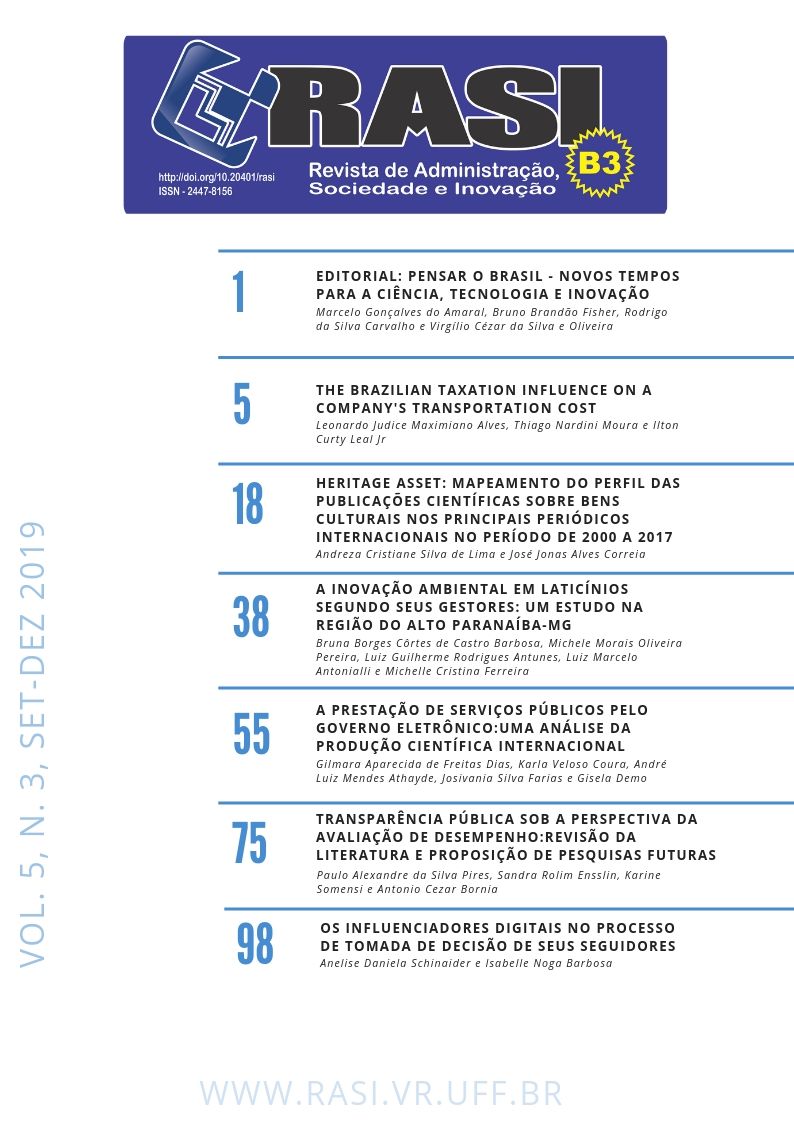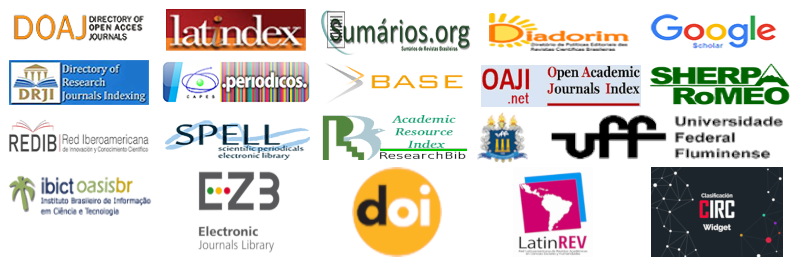A Prestação de Serviços Públicos pelo Governo Eletrônico
Uma Análise da Produção Científica Internacional
DOI:
https://doi.org/10.20401/rasi.5.3.294Keywords:
Governo Eletrônico. Entrega de serviços. Bibliometria. Agenda de Pesquisa.Abstract
A forma como o governo proporciona a entrega de serviços aos cidadãos tem sido influenciada pela modernização das Tecnologias de Informação e Comunicação (TIC’s) e pelo uso da internet, o que vem gerando acesso facilitado por meio do governo eletrônico (e-gov). Desse modo, este trabalho tem como objetivo analisar o perfil da produção científica internacional sobre a entrega de serviços públicos pelo governo eletrônico. Para tanto, buscou-se identificar nos artigos os elementos demográficos, explorando os objetivos, resumos e palavras-chave e verificando estatísticas textuais, especificidades de grupos, classificação hierárquica descendente e nuvens de palavras no corpus textual, composto por 21 artigos extraídos da base de dados do Science Direct Proquest. Como métodos de análise, foram utilizadas a bibliometria, a sociometria, por meio da aplicação do software Iramuteq, a classificação hierárquica descendente (CHD) e a análise fatorial de correspondência (AFC). Em linhas gerais, os resultados retrataram que a temática mais publicada refere-se à adoção de tecnologia seguida pela implementação do e-gov. A análise realizada desvelou os itinerários da produção científica internacional no tema e subsidiou a proposição de uma agenda de pesquisa para estudos ulteriores.
Downloads
References
Akinboade, O. A., Mokwena, M. P., & Kinfack, E. C. (2013). Understanding citizens'participation in service delivery protests in South Africa's Sedibeng district municipality. International Journal of Social Economics, 40(5), 458 – 478. URL: https://www.emeraldinsight.com/doi/abs/10.1108/03068291311315331
Alomari, M., Woods, P., & Sandhu, K. (2012). Predictors for e-government adoption in Jordan. Information Technology & People, 25(2), 207 – 234. URL: https://www.emeraldinsight.com/doi/abs/10.1108/09593841211232712
Araújo, R. F., Alvarenga, L. (2011). A bibliometria na pesquisa científica da pós-graduação brasileira de 1987 a 2007. Revista Eletrônica de Biblioteconomia, 16(31), 51-70. URL: https://periodicos.ufsc.br/index.php/eb/article/view/1518-2924.2011v16n31p51/17757
Ask, A., Hatakka, M., & Gronlund, A. (2008). The Orebro City citizen-oriented e-government strategy. International Journal of Electronic Government Research, 4(4), 69 – 88. URL: http://www.irma-international.org/viewtitle/21491/
Barbosa, A.F., Pozzebon, M., & Diniz, E. H. (2013). Rethinking e-government performance assessment from a citizen perspective. Public Administration, 91(3), 744 – 762. URL: https://pesquisa-eaesp.fgv.br/sites/gvpesquisa.fgv.br/files/arquivos/pozzebon_-_rethinking_e-government_performanceassessment_from_a_citizen_perspective.pdf
Bardin, L. (1977). Análise de Conteúdo. Lisboa: Edições 70.
Billestrup, J., Born, N., Bruun, A., & Stage, J. (2016). Usability problems found across public self-service applications and self-service providers. Paper presented at the Proceedings of the 28th Australian Conference on Computer-Human Interaction, Launceston, Tasmania, Australia.
Brown, M. M., & Brudney, J. L. (2004). Achieving advanced electronic government services: Opposing environmental constraints. Public Performance & Management Review, 28(1), 96 – 113. URL: https://www.tandfonline.com/doi/abs/10.1080/15309576.2004.11051819
Camargo, B. V. (2005). ALCESTE: Um programa informático de análise quantitativa de dados textuais. In A. S. P. Moreira, B. V. Camargo, J. C. Jesuíno, & S. M. Nóbrega (Eds.), Perspectivas teórico-metodológicas em representações sociais (pp. 511-539). João Pessoa, PB: Editora da Universidade Federal da Paraíba.
Chan, F.K.Y, Thong, J.Y.L, Venkatesh, V., Brown, S. A., Hu, P. J. H., & Tam, K. Y. (2010). Modeling citizen satisfaction with mandatory adoption of an e-government technology. Journal of the Association for Information Systems, 11(10), 519 – 549. URL: https://aisel.aisnet.org/cgi/viewcontent.cgi?referer=https://www.google.com/&httpsredir=1&article=1549&context=jais
Coursey, D., & Norris, D. F. (2008). Models of e?government: Are they correct? An empirical assessment. Public administration review, 68(3), 523-536. URL: https://pdfs.semanticscholar.org/0f5b/85d312b03d0a0bf433f1ca3b83b750417e1b.pdf
Criado, J. I., & Ramilo, M. C. (2003). E-government in practice An analysis of Web site orientation to the citizens in Spanish municipalities. The International Journal of Public Sector Management, 16(3), 191-2018. URL: https://www.emeraldinsight.com/doi/abs/10.1108/09513550310472320
Davis F. D., & Venkatesh V. (1996). A critical assessment of potential measurement biases in the technology acceptance model: Three experiments. Internat. J. Human-Comput. Stud., 45(1), 19 – 45. URL: https://www.sciencedirect.com/science/article/abs/pii/S1071581996900403
Farias, J. S., & Borges, D. M. (2012). Fatores Que Influenciam a Aceitação de Tecnologia: a Percepção de Gestores e Funcionários em uma Rede de Restaurantes. Revista Gestão & Tecnologia, 12(2), 141 – 167. URL: http://revistagt.fpl.edu.br/get/article/viewFile/401/432
Gallouj, F., & Weinstein, O. (1997). Innovation in services. Research Policy, 26(4-5), 537-556. URL: https://halshs.archives-ouvertes.fr/halshs-01133098/document
Guedes, V. L. S., & Borschiver, S. (2005). Bibliometria: uma ferramenta estatística para a gestão da informação e do conhecimento, em sistemas de informação, de comunicação e de avaliação científica e tecnológica. Encontro Nacional de Ciência da Informação, 6, 1 – 18. URL: http://www.cinform-anteriores.ufba.br/vi_anais/docs/VaniaLSGuedes.pdf
Guri-Rosenblit, S. (2005). Distance education and e-learning: Not the same thing. Higher Education, 49(4), 467 – 493. URL: https://www.researchgate.net/publication/226829906_'Distance_education'_and_'e-learning'_Not_the_same_thing
Janita, M. S., & Miranda, F. J. (2018). Quality in e-Government services: A proposal of dimensions from the perspective of public sector employees. Telematics and Informatics, 35(2), 457-469. URL: https://www.sciencedirect.com/science/article/abs/pii/S073658531730881X
Kai, E. (2012). Self?Service Society: Participative Politics and New Forms of Governance. Public Administration, 90(3), 685-698. URL: https://onlinelibrary.wiley.com/doi/abs/10.1111/j.1467-9299.2011.01996.x
Kai, E., & Vogt, H. (2013). On self-service democracy:Configurations of individualizing governance and self-directed citizenship. European Journal of Social Theory, 16(2), 153-173. URL: https://journals.sagepub.com/doi/abs/10.1177/1368431012459693?journalCode=esta
Keramati, A., Behmanesh, I., & Noori, H. (2018). Assessing the impact of readiness factors on e-government outcomes:An empirical investigation. Information Development, 34(3), 222-241. URL: https://journals.sagepub.com/doi/abs/10.1177/0266666916685603
Kronberger, N. E., & Wagner, W. (2002). Palavras-chave em contexto: análise estatística de textos. In: M.W. Bauer & G. Gaskell (Orgs.). Pesquisa qualitativa com texto, imagem e som: um manual prático. Petrópolis: Vozes.
Löffler, E. (2009). Why co-production is an important topic for local government. Governance International. URL: http://www.govint.org/fileadmin/user_upload/publications/coproduction_why_it_is_important.pdf
Meijer, A. (2011). Networked Co-Production of Public Services in Virtual Communities: From a Government-Centric to a Community Approach to Public Service Support. Public Administration Review, 71 (4), 598 – 607. URL: https://onlinelibrary.wiley.com/doi/abs/10.1111/j.1540-6210.2011.02391.x
Moon, M. J. (2002). The Evolution of E-Government among Municipalities: Rhetoric or Reality. Public Administration Review, 62(4), 424 – 433. URL: https://www.jstor.org/stable/3110357?seq=1#page_scan_tab_contents
Naoum, R., & Nadhim, Z. (2014). An Enhanced Model for E-Government: A Comparative Study between Jordanian and Iraqi Citizens. International Journal of Advanced Computer Research, 4, 11 – 18. URL: https://pdfs.semanticscholar.org/01a6/502813aa46c9eeaa6d7d0ff822243c027b59.pdf
Osborne, S. P., Radnor, Z., & Nasi, G. (2012). A New Theory for Public Service Management? Toward a (Public) Service-Dominant Approach. The American Review of Public Administration, 43(2), 135-158. URL: https://journals.sagepub.com/doi/abs/10.1177/0275074012466935?journalCode=arpb
Pereira, G. V., Rinnerbauer, B., Ginner, M., & Parycek, P. (2017). Categorizing Obstacles in e-Government: Formal and Informal. Paper presented at the Proceedings of the 10th International Conference on Theory and Practice of Electronic Governance, New Delhi AA, India.
Pestoff, V. (2006). Citizens and co-production of welfare services. Public Management Review, 8(4), 503-519. URL: https://www.researchgate.net/publication/247517818_Citizens_and_Co-production_of_Welfare_Services
Previtali, P., & Bof, F. (2009). E?government adoption in small Italian municipalities. International Journal of Public Sector Management, 22 (4), 338 – 348. URL: https://www.emeraldinsight.com/doi/abs/10.1108/09513550910961619?journalCode=ijpsm
Ramírez-Correa, P. E., Arenas-Gaitán, J., & Rondán-Cataluña, F. J. (2015). Gender and Acceptance of E-Learning: A Multi-Group Analysis Based on a Structural Equation Model among College Students in Chile and Spain. PLOS ONE, 10(10), 1 – 17. URL: https://journals.plos.org/plosone/article?id=10.1371/journal.pone.0140460
Ramos-Rodríguez, A., & Ruíz-Navarro, J. (2004). Changes in the Intellectual Structure of Strategic Management Research: A Bibliometric Study of the Strategic Management Journal, 1980-2000. Strategic Management Journal, 25(10), 981 – 1004. URL: https://onlinelibrary.wiley.com/doi/abs/10.1002/smj.397
Ranaweera, H. M. B. P. (2016). Perspective of trust towards e-government initiatives in Sri Lanka. SpringerPlus, 5(1), 22. URL: https://www.researchgate.net/publication/289586401_Perspective_of_trust_towards_e-government_initiatives_in_Sri_Lanka
Roy, J. (2017). Digital government and service delivery: An examination of performance and prospects. Canadian Public Administration, 60(4), 538-561. URL: https://onlinelibrary.wiley.com/doi/full/10.1111/capa.12231
Sadik, H. (2015). A Perception study on public response to E-service delivery in Bangladesh. Information Studies, 21(2), 151 – 166. URL: http://www.academia.edu/19577595/A_Perception_Study_on_Public_Response_to_E-service_Delivery_in_Bangladesh
Scott, J. K. (2005). E-Services: Assessing the Quality of Municipal Government Web Sites. State and Local Government Review, 37(2), 151 – 165. URL: https://www.jstor.org/stable/4355397?seq=1#page_scan_tab_contents
Sun, P., Ku, C., & Shih, D. (2015). An implementation framework for E-Government 2.0. Telematics and Informatics, 32(3), 504-520. URL: https://www.sciencedirect.com/science/article/abs/pii/S0736585314000926
Tesu, M. (2012). Developing e-government for better public services within European union. Theoretical and Empirical Researches in Urban Management, 7(2), 79 – 88. URL: https://ideas.repec.org/a/rom/terumm/v7y2012i2p79-89.html
Tolbert, C. J., & Mossberger, K. (2006). The Effects of E-Government on Trust and Confidence in Government. Public Administration Review, 66(3), 354 – 369. URL: https://onlinelibrary.wiley.com/doi/abs/10.1111/j.1540-6210.2006.00594.x
Vassilakis, C., Lepouras, G., Fraser, J., Haston, S., & Georgiadis, P. (2005). Barriers to electronic service development. E?Service Journal, 4(1), 41 – 63. URL: https://muse.jhu.edu/article/194042
West, D. M. (2004). E-government and the transformation of service delivery and citizen attitudes. Public Administration Review, 64(1), 15 – 27. URL: https://pdfs.semanticscholar.org/b302/18d3305a80dd0fd799961b5f4f892ef02ada.pdf
Downloads
Published
Issue
Section
License
RASI, in accordance with Law No. 9,610 of February 19, 1998, which amends, updates and consolidates Brazilian copyright law and makes other provisions, adopts the following conditions of the Copyright Assignment:
1. RASI maintains, with the transfer of copyrights, the possession of rights over the content published;
2. The author retains his moral rights of the content, including the right to be identified as the author whenever the content is published;
3. Despite the attribution of copyright, the author retains the right to reuse the material in future collections of his own work without encumbrance. The acknowledgments of the previous publication in the RASI are the only requirements in such cases;
4. The author may make photocopies of the content, or distribute it by electronic mail or fax, provided that they are intended for their own classes and for the purpose of meeting research objectives, provided that: (a) such copies are not resold and (b) reference to the original source of the publication and the name of the RASI are clearly indicated on all copies made of the document.











